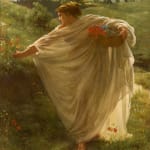Edward John Poynter 1836-1919
Framed: 35.5 x 32.5 cm.; 14 x 12¾ in.
Proserpine (Proserpina or Persephone in Greek) – Goddess of the Underworld whose myth represents the story of the seasons – was a popular subject in Victorian times as questions about the after-life, religious faith and the ideas of theosophy loomed large, all amid a Classical Revival which influenced paintings, sculpture, novels and the theatre. Subjects from classical mythology had become increasingly important stimuli for artists from the 1860s onwards. Notable interpretations of Proserpine include Walter Crane’s The Fate of Persephone (1878, sold Christie’s London, 12 June 2002); Lord Frederic Leighton’s The Return of Persephone (1891, Leeds Art Gallery) and Dante Gabriel Rossetti’s Proserpine, (1874, Tate Britain).
Rather than concentrating on the more dramatic moments of Proserpine’s myth – her abduction by Pluto (Hades), her eating the pomegranate seeds which ensure that she must return to the Underworld or her reunion with her mother Ceres (Demeter) who has been desperately searching for her – in this small, exquisite oil, Poynter offers an alternative vision. He depicts an instant of tranquil flower- gathering, where the figure seems to float weightlessly through an idealised Arcadian landscape. It relates to larger painting of Proserpine Poynter exhibited at the Royal Academy in 1869, depicting a young girl in classical robes picking flowers in a landscape. Agnes Poynter (the artist’s wife) wrote that it caused ‘quite a sensation, one hears of it on every side. We have just had another offer for it … the Queen insists upon a copy.’ (Christopher Wood, Olympian Dreamers, 1983, p. 138).
Poynter’s Proserpine is draped in a diaphanous white robe, which billows with sculptural grace while revealing the goddess’s silhouette through the translucent fabric. Golden, flowing ribbons crown her auburn hair, while delicate crimson sandals anchor her to the lush earth. She carries a wicker basket filled with vivid scarlet poppies and azure blooms, their symbolic meaning resonating with both life and death, consciousness and eternal slumber. Dappled sunlight filters through ancient trees, creating an atmosphere of a mystical sacred grove. Behind the figure is a hint of flowing water, whilst distant hills add compositional depth. Every element contributes to an overwhelming sense of lyrical beauty, transforming the mythological narrative into an aesthetic experience.
This intimate work marks a departure for Poynter, shifting away from his usual archaeological reconstructions towards a more emotionally immediate approach. The work’s contemporary relevance to Aesthetic Movement principles becomes clear through its focus on beauty rather than moral lessons, and classical form over modern social critique.
Provenance
Maas Gallery, London
Private Collection Ireland,
Private Collection, circa 1960s, thence by family descent
Join our mailing list
Be the first to hear about our upcoming exhibitions, events and news
* denotes required fields
We will process the personal data you have supplied to communicate with you in accordance with our Privacy Policy. You can unsubscribe or change your preferences at any time by clicking the link in our emails.




